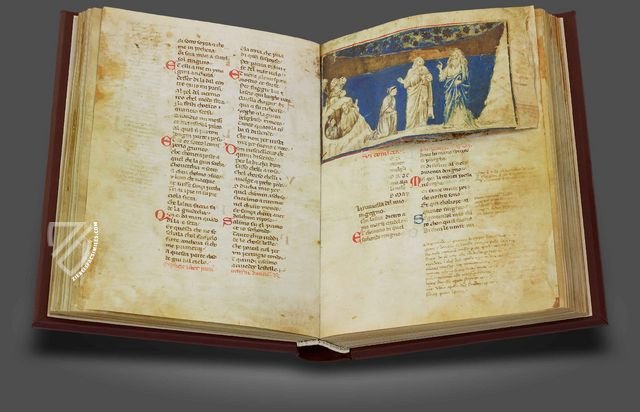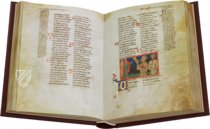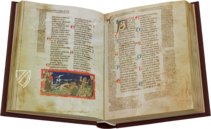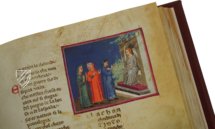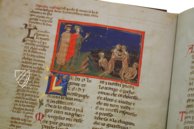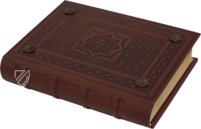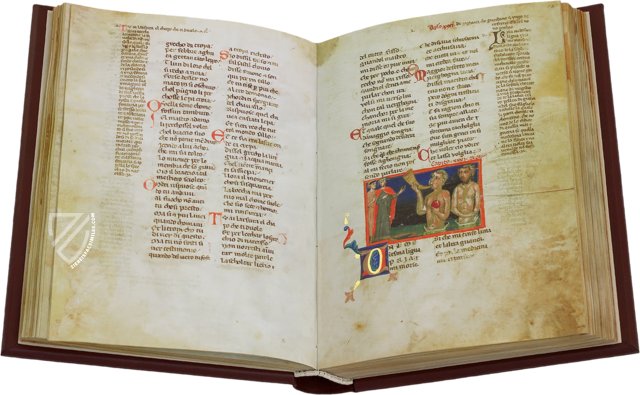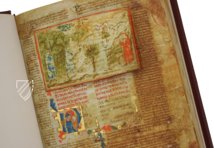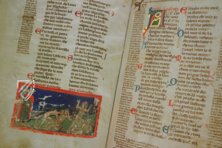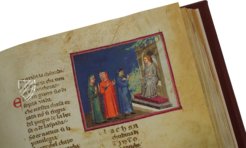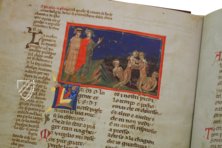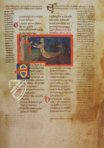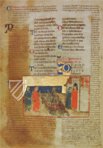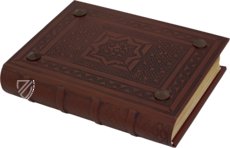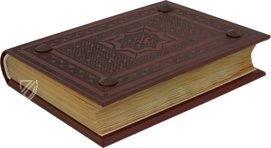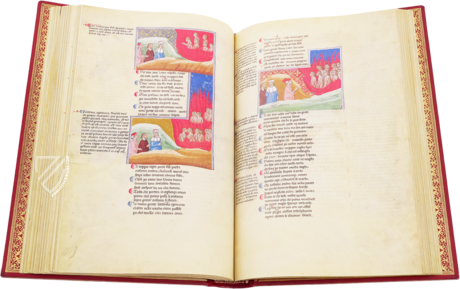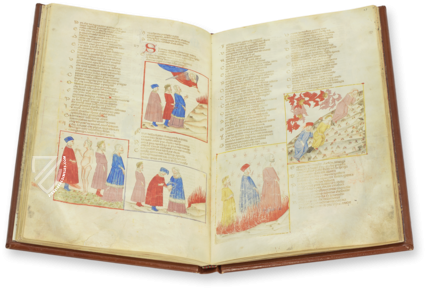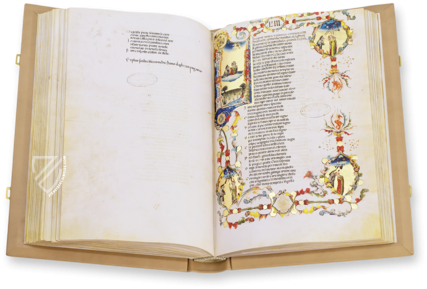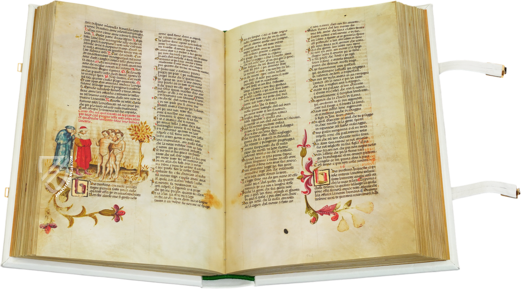Dante Alighieri - Divine Comedy - Dante Poggiali
(3,000€ - 7,000€)
This manuscript of the famous work by Dante Alighieri is sprawling with famous names and superlatives: originating from the second quarter of the Trecento in Florence, it is considered to be the oldest illustrated version of the Divine Comedy. The wonderful visual decoration originates from several great masters of their craft, inter alia, from the circle of Bernardo Daddi and from the circle of Pacino di Bonaguida. It is not only its content – alongside the primary text, it contains the commentaries of Jacopo della Lana, Jacopi di Dante, Guido da Pisa, and a few other accompanying texts – that make this manuscript a valuable historical document, it is a significant testimonial to this outstanding work of world literature!
Divine Comedy - Palat. 313 Manuscript
This manuscript of Dante Alighieri is sprawling with famous names and superlatives: originating from the second quarter of the Trecento in Florence, it is considered to be the oldest illustrated version of the Divine Comedy. The wonderful visual decoration originates from several great masters of their craft, inter alia, from the circle of Bernardo Daddi and from the circle of Pacino di Bonaguida. It is not only its content – alongside the primary text, it contains the commentaries of Jacopo della Lana, Jacopo di Dante, Guido da Pisa, and a few other accompanying texts – that make this manuscript a valuable historical document, it is a significant testimonial to this outstanding work of world literature!
The Comprehensive Content
Its artful arrangement already indicates the complexity of this manuscript: the primary text is written in two columns down the middle of the pages with the accompanying commentaries in glosses on the margins. These make the so-called Poggiali Codex a significant piece of evidence of the handwritten tradition of early Dante-commentaries. The manuscript contains the so-called Palatine Glosses. Italian and Latin glosses accompany the text of the Commedia along with the commentary by Jacopo di Dante, Dante’s son, as well as texts from Jacopo della Lana and Graziolo Bambaglioli: the Ottimo Commento, Anonimo Latino, and Anononimo Lombardo, as well as Guido de Pisa’s Declaratio.
Historically Significant Miniatures
Aside from this important position in literary history, the manuscript also enchants with its visual adornment. 37 miniatures (32 of them dedicated to the inferno), always arranged directly within the respective text, relate the events in colorful pictures. They are the work of various hands, among them were a master from the circle of Bernardo Daddi and a master from the circle of Pacino de Bonaguida (1280–1340). Colorful initials complete the artistic décor of the manuscript, which originates from the second quarter of the 14th century in Florence and is considered to be the oldest illustrated copy of the Divine Comedy.
The Template of the Poggiali
The manuscript, which is stored today under the shelf mark Ms. Pal. 313 in the Biblioteca Nazionale Centrale in Florence, is also known as the Poggiali-Codex. It was in the possession of Piero de Nero, a Florentine literati and politician of the late 16th century. From there it reached the library of the Guadagni family and finally came into the possession of Gaetano Poggiali (1753–1814), who used the manuscript as a template for his 1807 Commedia. This wonderful version of Dante not only offers a glimpse into this groundbreaking work of world literature, but also into its extremely interesting story within literary history.
Codicology
- Alternative Titles
- Divina Commedia Pal 313
Palatino 313
Dante Alighieri - Divine Comedy - Dante Poggiali - Size / Format
- 236 pages / 31.5 × 22.0 cm
- Origin
- Italy
- Date
- Second quarter of the 14th century
- Epochs
- Style
- Genre
- Language
- Illustrations
- 37 miniatures attributed to the workshop of Pacino di Buonaguida
- Artist / School
- Dante Alighieri (1265–1321) (author)
Jacopo di Dante (author)
Jacopo della Lana (author)
Guido da Pisa (author)
Circle of Bernardo Daddi (illuminators)
Circle of Pacino di Buonaguida (Bonaguida) (1280–1340) (illuminators) - Previous Owners
- Piero Del Nero, Guadagni family,
Gaetano Poggiali
Divine Comedy - Palat. 313 Manuscript
Canto XXXII and XXXIII
Canto XXXII: Dante and Virgil are crossing Cocytus, a frozen river in the Ninth Circle of Hell where sinners guilty of treachery are trapped in the ice. In the second ring, they see one sinner gnawing on the head of another. Canto XXXIII begins with the one doing the gnawing identifying himself as Count Ugolino and the man whose head he chews is Archbishop Ruggieri, who imprisoned Ugolino in a tower with his sons and denied them food, driving the starving man to eat the flesh of their corpses.
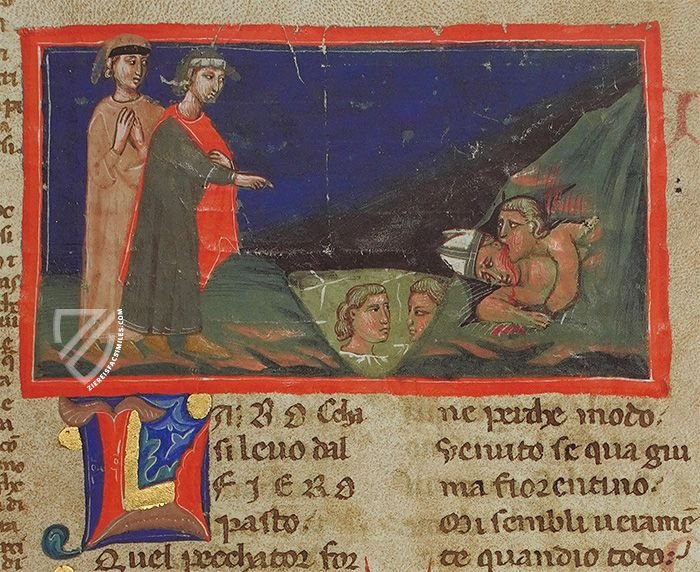
Divine Comedy - Palat. 313 Manuscript
Charon the Ferryman
After entering through the Gate of Hell and passing by the uncommitted souls in the Ante-Inferno who sided with neither God nor Satan in the War in Heaven, Virgil leads Dante to the banks of Acheron, the river marking the border of Hell. There they meet Charon, whose job it is to ferry the dead across the river and who is depicted here as an old man with some demonic features.
Charon initially refuses to transport the living Dante across the river and tells him to stay away from the dead, but Virgil informs him that their journey is divinely ordained, so the ferryman concedes. Having crossed to the other bank, Virgil and Dante enter a castle with seven walls where the souls of great and virtuous figures born before Christianity dwell.

#1 Palatino 313 - La Commedia di Dante Alighieri
Language: Italian
(3,000€ - 7,000€)
- Treatises / Secular Books
- Apocalypses / Beatus
- Astronomy / Astrology
- Bestiaries
- Bibles / Gospels
- Chronicles / History / Law
- Geography / Maps
- Saints' Lives
- Islam / Oriental
- Judaism / Hebrew
- Single Leaf Collections
- Leonardo da Vinci
- Literature / Poetry
- Liturgical Manuscripts
- Medicine / Botany / Alchemy
- Music
- Mythology / Prophecies
- Psalters
- Other Religious Books
- Games / Hunting
- Private Devotion Books
- Other Genres
- Afghanistan
- Armenia
- Austria
- Belgium
- Colombia
- Croatia
- Cyprus
- Czech Republic
- Denmark
- Egypt
- Ethiopia
- France
- Germany
- Greece
- Hungary
- India
- Iran
- Iraq
- Israel
- Italy
- Japan
- Lebanon
- Luxembourg
- Mexico
- Morocco
- Netherlands
- Palestine
- Peru
- Poland
- Portugal
- Russia
- Serbia
- Spain
- Sri Lanka
- Sweden
- Switzerland
- Syria
- Turkey
- Ukraine
- United Kingdom
- United States
- Uzbekistan
- Aboca Museum
- Ajuntament de Valencia
- Akademie Verlag
- Akademische Druck- u. Verlagsanstalt (ADEVA)
- Aldo Ausilio Editore - Bottega d’Erasmo
- Alecto Historical Editions
- Alkuin Verlag
- Almqvist & Wiksell
- Amilcare Pizzi
- Andreas & Andreas Verlagsbuchhandlung
- Archa 90
- Archiv Verlag
- Archivi Edizioni
- Arnold Verlag
- ARS
- Ars Magna
- ArtCodex
- AyN Ediciones
- Azimuth Editions
- Badenia Verlag
- Bärenreiter-Verlag
- Belser Verlag
- Belser Verlag / WK Wertkontor
- Benziger Verlag
- Bernardinum Wydawnictwo
- BiblioGemma
- Biblioteca Apostolica Vaticana (Vaticanstadt, Vaticanstadt)
- Bibliotheca Palatina Faksimile Verlag
- Bibliotheca Rara
- Boydell & Brewer
- Bramante Edizioni
- Bredius Genootschap
- Brepols Publishers
- British Library
- C. Weckesser
- Caixa Catalunya
- Canesi
- CAPSA, Ars Scriptoria
- Caratzas Brothers, Publishers
- Carus Verlag
- Casamassima Libri
- Chavane Verlag
- Christian Brandstätter Verlag
- Circulo Cientifico
- Club Bibliófilo Versol
- Club du Livre
- CM Editores
- Collegium Graphicum
- Collezione Apocrifa Da Vinci
- Comissão Nacional para as Comemorações dos Descobrimentos Portugueses
- Coron Verlag
- Corvina
- CTHS
- D. S. Brewer
- Damon
- De Agostini/UTET
- De Nederlandsche Boekhandel
- De Schutter
- Deuschle & Stemmle
- Deutscher Verlag für Kunstwissenschaft
- DIAMM
- Droz
- E. Schreiber Graphische Kunstanstalten
- Ediciones Boreal
- Ediciones Grial
- Ediclube
- Edições Inapa
- Edilan
- Editalia
- Edition Deuschle
- Edition Georg Popp
- Edition Leipzig
- Edition Libri Illustri
- Editiones Reales Sitios S. L.
- Éditions de l'Oiseau Lyre
- Editions Medicina Rara
- Editorial Casariego
- Editorial Mintzoa
- Editrice Antenore
- Editrice Velar
- Edizioni Edison
- Egeria, S.L.
- Eikon Editores
- Electa
- Emery Walker Limited
- Enciclopèdia Catalana
- Eos-Verlag
- Ephesus Publishing
- Ernst Battenberg
- Eugrammia Press
- Extraordinary Editions
- Fackelverlag
- Facsimila Art & Edition
- Facsimile Editions Ltd.
- Facsimilia Art & Edition Ebert KG
- Faksimile Verlag
- Feuermann Verlag
- Folger Shakespeare Library
- Franco Cosimo Panini Editore
- Friedrich Wittig Verlag
- Fundación Hullera Vasco-Leonesa
- G. Braziller
- Gabriele Mazzotta Editore
- Gebr. Mann Verlag
- Gesellschaft für graphische Industrie
- Getty Research Institute
- Giovanni Domenico de Rossi
- Giunti Editore
- Graffiti
- Grafica European Center of Fine Arts
- Guido Pressler
- Guillermo Blazquez
- Gustav Kiepenheuer
- H. N. Abrams
- Harrassowitz
- Helikon
- Hendrickson Publishers
- Henning Oppermann
- Herder Verlag
- Hes & De Graaf Publishers
- Hoepli
- Holbein-Verlag
- Hortus Deliciarum
- Houghton Library
- Hugo Schmidt Verlag
- Idion Verlag
- Il Bulino, edizioni d'arte
- ILte
- Imago
- Insel Verlag
- Instituto Nacional de Antropología e Historia
- Istituto dell'Enciclopedia Italiana - Treccani
- Istituto Ellenico di Studi Bizantini e Postbizantini
- Istituto Geografico De Agostini
- Istituto Poligrafico e Zecca dello Stato
- Italarte Art Establishments
- J. Thorbecke
- Jan Thorbecke Verlag
- Johnson Reprint Corporation
- Josef Stocker
- Josef Stocker-Schmid
- Jugoslavija
- Karl W. Hiersemann
- Kasper Straube
- Kaydeda Ediciones
- Kindler Verlag / Coron Verlag
- Kodansha International Ltd.
- Konrad Kölbl Verlag
- Kurt Wolff Verlag
- La Liberia dello Stato
- La Linea Editrice
- La Meta Editore
- Lambert Schneider
- Landeskreditbank Baden-Württemberg
- Leo S. Olschki
- Les Incunables
- Library of Congress
- Libreria Musicale Italiana
- Lichtdruck
- Lito Immagine Editore
- Lumen Artis
- Lund Humphries
- M. Moleiro Editor
- Maison des Sciences de l'homme et de la société de Poitiers
- Manuscriptum
- Martinus Nijhoff
- Maruzen-Yushodo Co. Ltd.
- MASA
- McGraw-Hill
- Militos
- Millennium Liber
- Müller & Schindler
- Nahar and Steimatzky
- National Library of Wales
- Neri Pozza
- Nova Charta
- Oceanum Verlag
- Odeon
- Orbis Mediaevalis
- Orbis Pictus
- Österreichische Staatsdruckerei
- Oxford University Press
- Pageant Books
- Parzellers Buchverlag
- Patrimonio Ediciones
- Pattloch Verlag
- PIAF
- Pieper Verlag
- Plon-Nourrit et cie
- Prestel Verlag
- Princeton University Press
- Prisma Verlag
- Priuli & Verlucca, editori
- Pro Sport Verlag
- Propyläen Verlag
- Pytheas Books
- Quaternio Verlag Luzern
- Reales Sitios
- Recht-Verlag
- Reichert Verlag
- Reichsdruckerei
- Riehn & Reusch
- Roberto Vattori Editore
- Rosenkilde and Bagger
- Roxburghe Club
- Salerno Editrice
- Sarajevo Svjetlost
- Schöck ArtPrint Kft.
- Scolar Press
- Scrinium
- Scripta Maneant
- Scriptorium
- Siloé, arte y bibliofilia
- SISMEL - Edizioni del Galluzzo
- Sociedad Mexicana de Antropología
- Société des Bibliophiles & Iconophiles de Belgique
- Soncin Publishing
- Sorli Ediciones
- Stainer and Bell
- Studer
- Styria Verlag
- Sumptibus Pragopress
- Szegedi Tudomànyegyetem
- Taberna Libraria
- Tarshish Books
- Taschen
- Tempus Libri
- Testimonio Compañía Editorial
- Thames and Hudson
- The Clear Vue Publishing Partnership Limited
- The Facsimile Codex
- The Folio Society
- The Marquess of Normanby
- The Richard III and Yorkist History Trust
- Tip.Le.Co
- TouchArt
- TREC Publishing House
- TRI Publishing Co.
- Trident Editore
- Typis Regiae Officinae Polygraphicae
- Union Verlag Berlin
- Universidad de Granada
- University of California Press
- University of Chicago Press
- Urs Graf
- Vallecchi
- Van Wijnen
- VCH, Acta Humaniora
- VDI Verlag
- VEB Deutscher Verlag für Musik
- Verlag Anton Pustet / Andreas Verlag
- Verlag Bibliophile Drucke Josef Stocker
- Verlag der Münchner Drucke
- Verlag für Regionalgeschichte
- Verlag Styria
- Vicent Garcia Editores
- W. Turnowsky
- Waanders Printers
- Wiener Mechitharisten-Congregation (Wien, Österreich)
- Wissenschaftliche Buchgesellschaft
- Wydawnictwo Dolnoslaskie
- Xuntanza Editorial
- Zakład Narodowy
- Zollikofer AG

